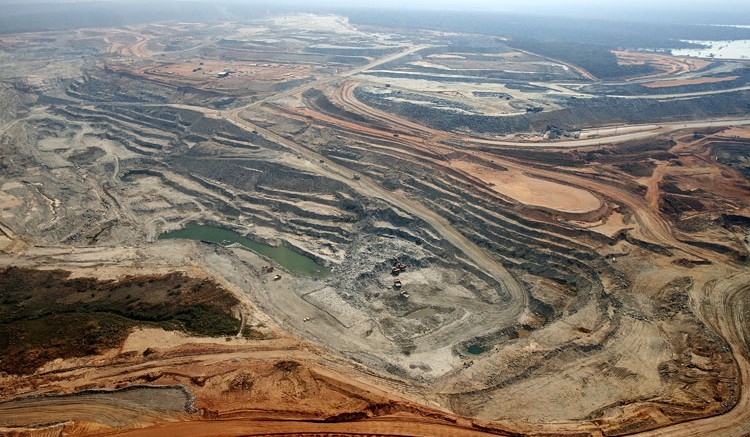VANCOUVER – Copper isn’t turning out to be the growth avenue Barrick Gold (ABX-X) hoped it would be.
The gold major jumped into the copper scene in 2011 with the $7.3-billion acquisition of Equinox Minerals, owner of the Lumwana mine in Zambia. At the time copper was selling for more than US$4.50 per lb. amidst booming demand from China.
Two years later, Barrick has found out Lumwana isn’t quite the mine it was chalked up to be – or at least is not an operation that works at today’s lower copper prices. A new life-of-mine model for the operation shows higher-than-expected operating and sustaining costs, which means lower-than-expected production and profitability.
As a result, Barrick just recorded an after-tax asset impairment charge of US$3 billion for Lumwana plus a goodwill impairment charge of US$800 million for its copper business unit, which also includes the Zaldivar mine in Chile.
Taking a $3.8-billion writedown on a fairly recent $7.3-billion investment means something went seriously awry. For Barrick, that something was the idea to pursue production growth at any cost.
Aaron Regent, Barrick’s previous CEO and the architect of the Lumwana deal, certainly pursued that goal. Unfortunately, his narrow focus on production growth got him fired when it became clear that adding ounces and pounds was not necessarily adding net dollars to Barrick’s balance sheet. In addition, the model certainly wasn’t doing any good for Barrick’s share price, which had dipped to a post-recession low of $32 when Regent was shown the door.
A big part of the problem was that Regent assumed copper prices would not only stay strong, but would rise. Instead, copper prices have slipped about 25% since the acquisition.
No surprise, then, that Barrick repeatedly reinforcing the company’s new focus on stricter, more disciplined capital allocation in announcing its latest results, including the writedown.
“Rising costs, poor capital allocation, and the pursuit of production growth at any cost in the industry have led to declining equity valuations across the sector,” said Barrick’s current CEO, Jamie Sokalsky, who replaced Regent in mid-2012. “The message is clear: the industry must chart a new path forward… We are increasingly taking strong action and re-focusing our business based on the principle that returns will drive production, production will not drive returns.”
Since his appointment last year, Sokalsky has made it clear that he is focused on rates of return, not production growth. In his six months at the helm he has already deferred some $4 billion in previously budgeted capital spending and shelved plans to build new mines. In fact, Barrick currently has no plans to build any new mines, a point it made several times in its earnings release.
Sliding copper prices were not the sole culprit at Lumwana. In the latter part of 2012 Barrick completed an exploration and infill drill program at the project aimed at better defining the limits of mineralization. The results were apparently not impressive.
“After this drilling was completed, the orebody did not meet economic expectations,” Barrick wrote in its release. “While the drilling increased reserves and defined significant amounts of additional mineralization, some at higher grades, much of it was deep and would require a significant amount of waste stripping, which makes it uneconomic based on expected operating costs and current market copper prices.”
In 2012 Lumwana produced 468 million lbs. copper, with each pound costing a total of US$2.97 to produce. For 2013 Barrick plans to produce only half as much from the Zambian mine, and those pound will come at higher cost: guidance calls for output of 210 to 250 million lbs. at an average fully allocated cost of US$3.20 to US$3.60 per lb.
The company has also shelved earlier plans to expand Lumwana, reinforcing the idea that it “…will not invest capital simply to increase production.”
Sokalsky tried to put a silver lining on the dark Lumwana cloud, ending his discussion of the $3.8-billion writedown by suggesting higher copper prices in the future will restore immense value to the mine.
“When we bought Equinox, our view was that Lumwana was a very long-life mine, with exceptional resource potential in the Chimiwungo area,” Sokalsky wrote. “Our view of the resource potential has been validated by the results of our exploration program – Lumwana has an enormous mineral inventory and tremendous leverage to higher copper prices. As copper becomes more difficult to find and demand increases, we stand to benefit substantially from having this asset in our portfolio.”
Barrick also had a few other, more positive pieces of news. Despite the huge copper writedown, the company still managed to bring in adjusted net earnings of US$3.8 million for the year, the second highest in the company’s history.
The company has also contained the capital cost overruns at its construction-stage Pascua-Lama gold project, which is now expected to cost a total of US$8 to US$8.5 billion. Pascua-Lama is truly a world-class resource, with nearly 18 million oz. of proven and probable gold as well as 676 million oz. of silver. The mine is expected to produce 800,000 oz. of gold and 35 million oz. of silver annually for 25 years, with initial production now expected in the middle of 2014.
Barrick’s share price gained 72¢ on the news to close at $32.44. The company has a 52-week trading range of $31.18 to $49.93 and has just over 1 billion shares outstanding.


Be the first to comment on "Barrick takes US$3.8B hit on Lumwana copper mine"